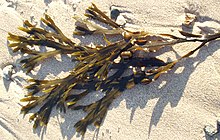Bladderwrack
| Fucus vesiculosus | |
|---|---|
 |
|
| Scientific classification | |
| (unranked): | SAR |
| Superphylum: | Heterokonta |
| Class: | Phaeophyceae |
| Order: | Fucales |
| Family: | Fucaceae |
| Genus: | Fucus |
| Species: | F. vesiculosus |
| Binomial name | |
|
Fucus vesiculosus L. |
|
| External identifiers for Fucus vesiculosus | |
|---|---|
| Encyclopedia of Life | 893114 |
| ITIS | 11335 |
| NCBI | 49266 |
| WoRMS | 145548 |
| Also found in: , MarLIN, AlgaeBase | |
Fucus vesiculosus, known by the common name bladder wrack or bladderwrack, is a seaweed found on the coasts of the North Sea, the western Baltic Sea, and the Atlantic and Pacific Oceans, also known by the common names black tang, rockweed, bladder fucus, sea oak, black tany, cut weed, dyers fucus, red fucus, and rock wrack. It was the original source of iodine, discovered in 1811, and was used extensively to treat goitre, a swelling of the thyroid gland related to iodine deficiency.
The fronds of F. vesiculosus grow to 90 centimetres (35 in) long and 2.5 centimetres (1.0 in) wide and have a prominent midrib throughout. It is attached by a basal disc-shaped holdfast. It has almost spherical air bladders which are usually paired, one on either side of the mid-rib, but may be absent in young plants. The margin is smooth and the frond is dichotomously branched. It is sometimes confused with Fucus spiralis with which it hybridises and is similar to Fucus serratus.
Fucus vesiculosus is a common large alga on the shores of the British Isles. It has been recorded from the Atlantic shores of Europe, Northern Russia, the Baltic Sea, Greenland, Azores, Canary Islands, Morocco and Madeira. It is also found on the Atlantic coast of North America from Ellesmere Island, Hudson Bay to North Carolina.
The species is especially common on sheltered shores from the middle littoral to lower intertidal levels. It is rare on exposed shores where any specimens may be short, stunted and without the air vesicles.F. vesiculosus supports few colonial organisms but provides a canopy and shelter for the tube worm Spirorbis spirorbis, herbivorous isopods, such as Idotea and surface grazing snails such as Littorina obtusata.Phlorotannins in Fucus vesiculosus act as chemical defences against the marine herbivorous snail Littorina littorea. Nevertheless, galactolipids, rather than phlorotannins, act as herbivore deterrents in this species against the sea urchin Arbacia punctulata.Methyl-jasmonate may induce the phlorotannins production.Fucophlorethol A is a type of phlorotannin found in F. vesiculosus.
...
Wikipedia
